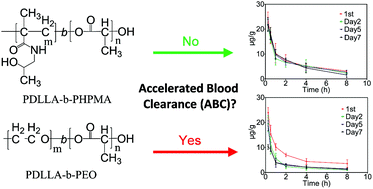Poly(d,l-lactic acid)-block-poly(N-(2-hydroxypropyl)methacrylamide) nanoparticles for overcoming accelerated blood clearance and achieving efficient anti-tumor therapy†
Abstract
Well-defined poly(D,L-lactic acid)-block-poly(N-(2-hydroxypropyl)methacrylamide) (PDLLA-b-PHPMA) copolymers were synthesized by the combination of ring opening polymerization (ROP) and reversible addition–fragmentation chain transfer (RAFT) polymerization techniques. Paclitaxel loaded nanoparticles based on these copolymers were prepared with the emulsion/solvent evaporation method. The biological properties such as the interaction with macrophage cells, the cytotoxicity against 4T1 tumor cells, blood clearance, in vivo biodistribution and the anti-tumor efficacy of nanoparticles with different compositions have been investigated. Low reticuloendothelial system (RES) uptake and high tumor accumulation could be observed for PDLLA-b-PHPMA nanoparticles in the preliminary results. When compared with PEG, PHPMA showed a similar performance in decreasing macrophage uptake and prolonging blood circulation. The tumor growth inhibition assay has proved the great potential of PDLLA-b-PHPMA to act as efficient drug carriers against murine breast cancer models. More importantly, the introduction of PHPMA may help to alleviate the accelerated blood clearance (ABC) phenomenon of PDLLA-b-PEG.



 Please wait while we load your content...
Please wait while we load your content...